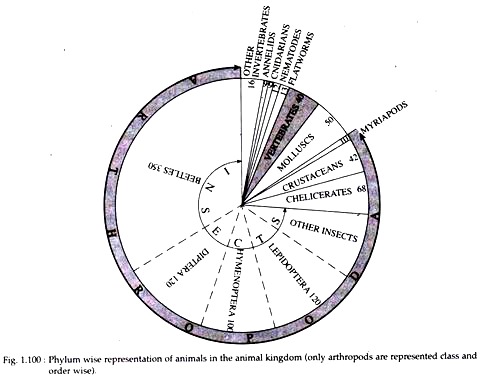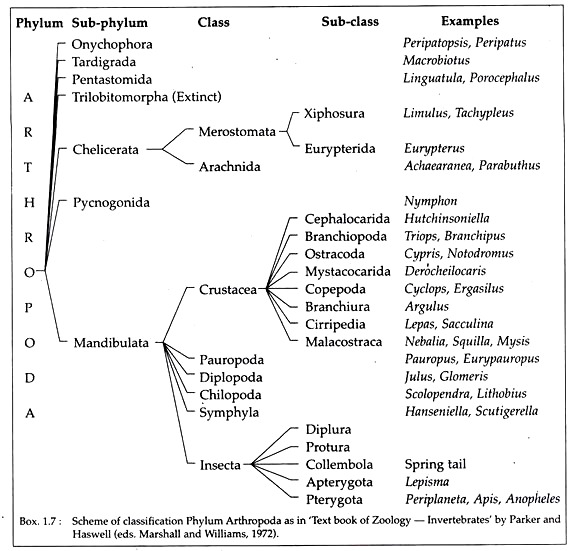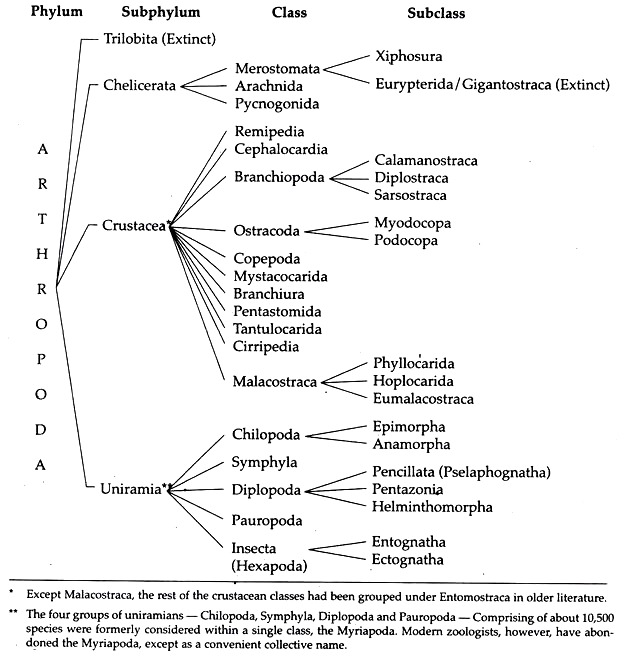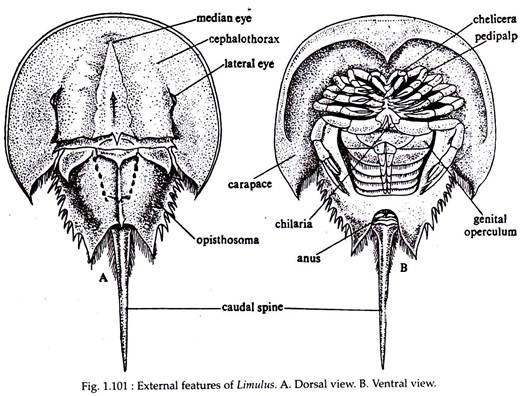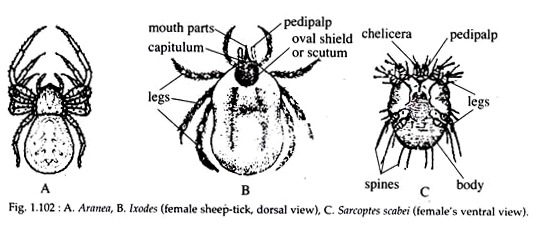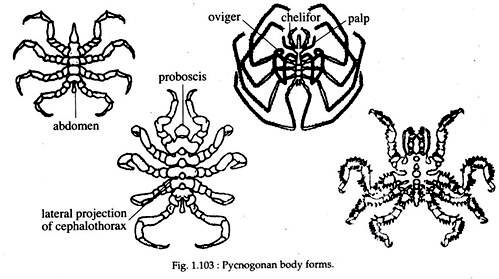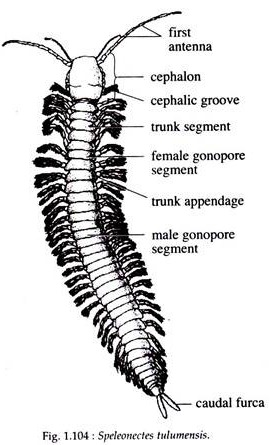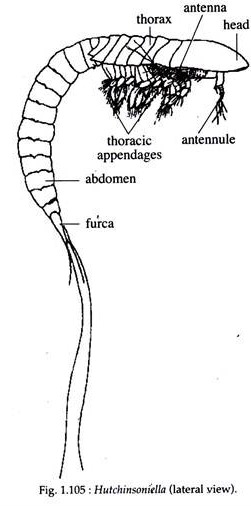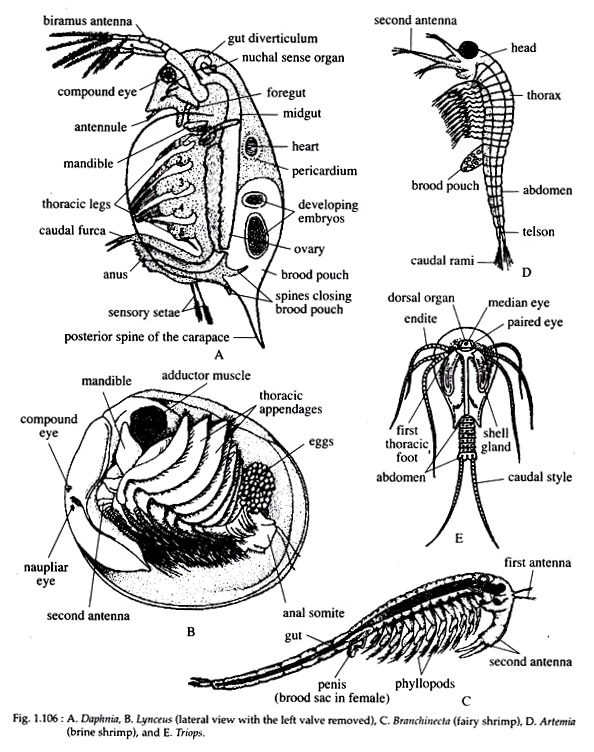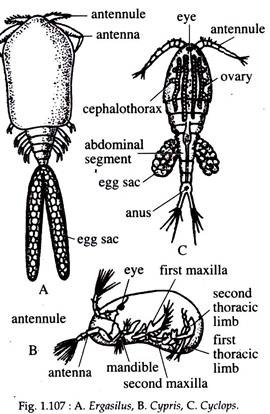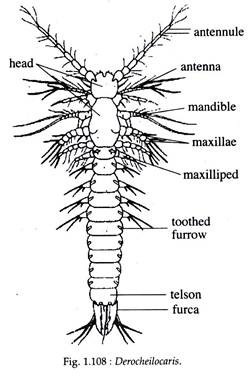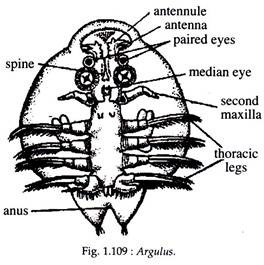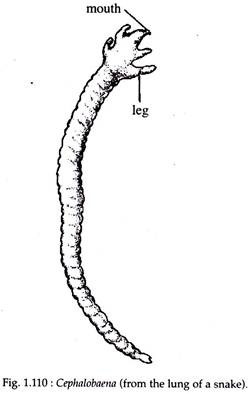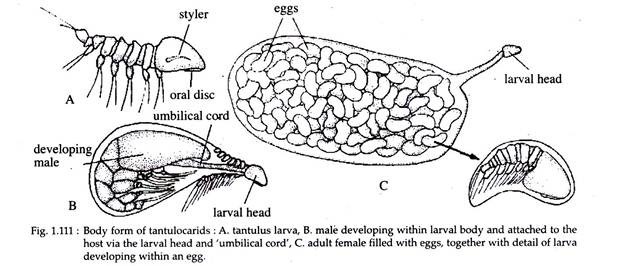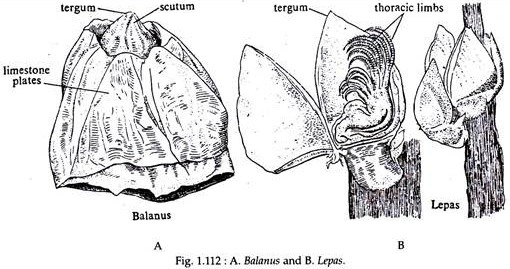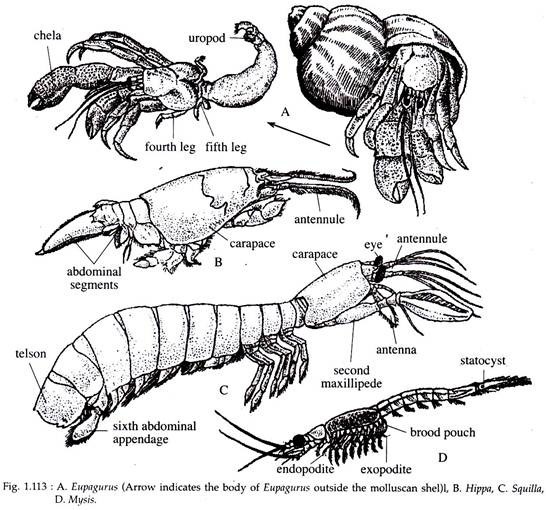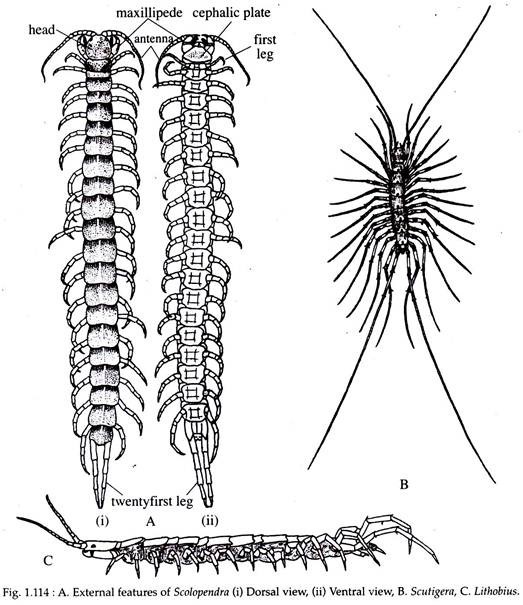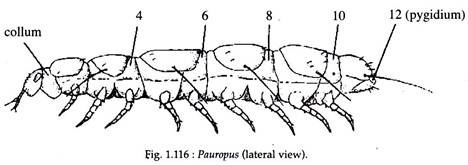In this article we will discuss about the Phylum Arthropoda:- 1. Introduction to Phylum Arthropoda 2. Diagnostic Features of Phylum Arthropoda 3. Scheme of Classification 4. Systematic Resume.
Introduction to Phylum Arthropoda:
Arthropoda represents a vast assemblage of animals. At least three quarters of a million species have been described. The phylum includes several large classes, but its importance lies mainly in the fact that it contains the class insecta which by itself represents almost three quarters of all described animal species (Fig. 1.100).
No other phylum of animals can rival the arthropods in success, which is due to the tremendous adaptive diversity that has enabled them to survive virtually in every habitat. Their success as terrestrial animal is probably due to the evolution of water- conserving excretory systems and gaseous- exchange organs and the development of a desiccation-resistant impermeable epicuticle.
ADVERTISEMENTS:
Etymology:
Greek: arthron, joint; podos, feet.
Diagnostic Features of Phylum Arthropoda:
1. Segmented body with bilateral symmetry.
2. Anterior segments specialized to form a distinct head.
ADVERTISEMENTS:
3. Body is externally covered with a thick, tough and non-living, chitinous cuticle, forming the exoskeleton.
4. A pair of externally jointed appendages is usually present in each segment.
5. Arthropods exhibit ecdysis or moulting. They shed off the old exoskeleton and a new one develops from the underlying epidermis.
6. Presence of musculature with distinct striped muscles. Muscles are attached to the inner surface of the skeletal system.
ADVERTISEMENTS:
7. Body cavity is haemocoel. True coelom is vestigeal in adults.
8. Mouth and anus are present at the two terminal ends of the body.
9. Circulation is of the open-type (i.e. blood vessels open within haemocoel). Paired lateral ostia permit the passage of blood into the dorsal pulsating tube – the heart, from the surrounding pericardial sinus.
10. Haemocyanin is the respiratory pigment.
11. Arthropods possess two types of excretory organs—malpighian tubules and saccules (end sacs). Saccules take the name of the appendage with which it is associated, like coxal glands, green glands, maxillary glands and so forth.
12. Nervous system consists of a cerebral ganglionic mass connected to two ventral nerve cord with segmental ganglia.
13. Sense organs are sensillum (hair, bristle, seta, pit, peg etc.) and compound eyes. The compound eyes are composed of many long, cylindrical units (ommatidium), each of which contains all the visual elements.
14. Most arthropods are dioecious with sexual dimorphism. Eggs are centrolecithal and cleavage commonly superficial.
15. Development may be direct or indirect.
Scheme of Classification of Phylum Arthropoda:
Modern zoologists believe that there are probably four main lines of arthropod evolution. These lines are represented by the extinct Trilobita and the three living- Chelicerata, Crustacea and Uniramia. The uniramia contains the flourishing insecta. The first three groups have marine origin, while uniramia appears to have evolved on land.
Evidences from comparative morphology and embryology seems, that at least the uniramians and probably even all four of the above arthropod groups had a separate origin from different annelidan or near annelidan ancestors.
In view of this, Arthropoda should be considered as a super-phylum and Trilobita, Chelicerata, Crustacea and Uniramia should each be raised to phylum rank (as has been done by Barnes et al, 1993; Barnes, 1998).
However, in this text, the traditional rank of phylum has been retained for Arthropoda and the four lines of its evolution have been recognized as subphyla. The classification retained here is after the classificatory plan as outlined by Ruppert and Barnes, 1994.
Systematic Resume of Phylum Arthropoda:
Subphylum Trilobita (extinct):
Trilobites were abundant and widely distributed in Paleozoic seas. They reached their height during Cambrian and Ordovician period and disappeared at the end of Palaeozoic era. From fossil specimens about 3900 species have been described.
Subphylum Chelicerata (Greek: chele, talon; cerata, horns)
1. Bilaterally symmetrical. Body shape varying from elongated to almost spherical.
2. Body divided into an anterior cephalothorax or prosoma, which is wholly or partly covered by a dorsal carapace, and a posterior abdomen or opisthosoma without legs.
3. Appendages uniramous. Pro-somal appendages present, comprising of a pair of chelate ‘chelicerae’ (helps in feeding), one pair of chelate leg-like or feeler like ‘pedipalps’ (helps in various functions) and four pairs of walking legs.
4. Chelicerates are the only arthropods which lack antennae.
5. Mouth anteroventral. Gut straight. From the mid gut region arise two to many pairs of digestive diverticula which secrete enzymes that intracellularly digest and absorb food.
6. Median ocelli are present.
7. Development generally direct, juvenile with the full complement of limbs.
Chelicerata contains about 63,000 described species placed in three classes.
Class Merostomata:
1. Aquatic chelicerates with five or six pairs of abdominal appendages modified as gills.
2. Twelve segmented abdomen is subdivided into a seven segmented meso- soma and a five segmented metasoma.
3. A prominent spike like caudal spine or telson is present at the end of the body.
4. Compound eyes fairly developed.
Subclass Xiphosura:
1. Bottom dwellers, nocturnal, found in shallow coastal water and are commonly known as horse-shoe crabs.
2. Prosoma is covered by a large, horseshoe shaped carapace.
3. Caudal spine is elongated, slender and pointed.
4. Abdominal segments fused and bear six pairs of appendages.
5. Lamellate gills or book gills are present in five pairs (on the appendages of ninth to thirteenth segments).
6. Excretion takes place by four pairs of coxal glands.
7. Development through trilobite larval stage.
This subclass contains 3 genera and four species.
Examples:
Limulus (Fig. 1.101), Tachypleus, Carcinoscorpius
Subclass Eurypterida (Extinct):
This subclass is also known as Gigantostraca and comprises of the extinct giant arthropods. They were aquatic and existed from the Ordovician to the Permian period.
Class Arachnida:
1. Except a few (secondarily aquatic) forms, the arachnida includes all living terrestrial chelicerates.
2. Predator arachnids use poison or silk in prey capture.
3. Prosoma un-segmented, usually covered dorsally by a solid carapace. The primitive abdomen is divided into a pre- abdomen and a post-abdomen.
4. Prosoma consists of a pair of chelicerae, a pair of pedipalps and four pairs of legs.
5. Respiratory organs are either book lungs or trachea.
6. The epicuticle is waterproof due to an external wax layer.
7. Excretion by malpighian tubules, coxal glands and nephrocytes.
8. Eyes usually simple. Compound eyes when present are degenerated.
9. Sexes separate, single or paired gonads that lie in the abdomen. Fertilization is internal.
The arachnids comprise of over 98% of living chelicerates and include over 62,000 species.
Examples:
True scorpion (Buthus, Palamnaeus), Micro-whip scorpion (Koenenia), Pseudo-scorpion (Chelifer), True spiders (Aranea) (Fig. 1.102A), Mites and ticks (Ixodes (Fig. 1.102B), Sarcoptes (Fig. 1.102C), Argas).
Class Pycnogonida:
1. Small, benthic marine animals commonly known as sea spiders.
2. Opisthosoma much reduced.
3. The head or cephalon bears four eyes and at its anterior end a cylindrical proboscis.
4. A pair of palps, a pair of ovigerous legs and usually four pairs of walking legs are present.
5. No special organs for gas exchange and excretion are present.
6. Reproductive openings are multiple and are present on the ventral side of coxae (all legs in females, second and fourth pair in males).
7. Dioecious. Development usually through a larva called protonymphon.
More than 1,000 species have been described and placed in a single order.
Example:
Nymphon, Pallene, Decolopoda, Pycnogonum
Subphylum Crustacea (Latin: crusta, a rind or crust)
1. Primarily marine although several are freshwater (13%) and a few are terrestrial (3%).
2. Head bears five pairs of appendages which comprise of two pairs of antennae (first pair being the antennules), one pair of mandibles and two pairs of maxillae.
3. The cylindrical or leaf-shaped appendages are all typically biramous, the two branches are of different size and shape.
4. Exoskeleton often calcareous.
5. Respiration usually through gills, which are typically associated with the appendages.
6. Excretory organs are paired and composed of an end sac, an excretory canal and a short exit duct, all located in the head.
7. Head bears a pair of compound eyes, sometimes located on movable stalks and a small median dorsal naupliar eye.
8. Dioecious. Copulation and egg brooding are very common. Development through different larval stages like nauplius, zoea etc.
About 40,000 species of this subphylum are divided into eleven classes.
Class Remipedia:
1. Marine animals with small, elongated, worm like and translucent body.
2. Body comprises of a short, carapace-less cephalothorax (head and first trunk segment) and a long trunk of over 30 similar segments, each with a pair of leaf-like, lateral limbs.
3. They are carnivorous and the first pair of trunk appendages are modified as prehensile maxillipeds for feeding. Other trunk appendages help in swimming.
4. Absence of eyes.
5. Hermaphrodite. Development still unknown.
They were first discovered in 1981 and is represented by nine species.
Examples: Lasionectes, Speleonectes (Fig. 1.104).
Class Cephalocarida:
1. Bottom dwelling, marine animals and are detritus feeder.
2. Body small, elongated and cylindrical, terminating in a telson with a long furca.
3. The body is divided into a horseshoe- shaped head, thorax and abdomen, without any development of cephalothorax or carapace.
4. All eight pairs of thoracic limbs are identical and similar to the second maxillae.
5. The eleven segmented abdomen lacks appendages, except the first which retains reduced limbs.
6. Although compound eyes are present they are blind as these eyes are buried in the head.
7. Hermaphrodite and development includes metanauplius stage.
Discovered in 1955 and is represented by ten species.
Example: Hutchinsoniella (Fig. 1.105).
Class Branchiopoda (gill feet):
1. Small crustaceans mainly restricted to fresh water.
2. Trunk appendages are flattened leaf like structures
3. Coxa is provided with a flattened epipod that serves as a gill and hence the name “gill feet”.
4. First antenna and second maxilla are vestigeal.
5. The last abdominal segment bears a two terminal process called cercopods.
6. Excretion by maxillary glands or shell glands.
7. Branchiopods brood their eggs.
This class comprises of about 850 living species.
Subclass Calamanostraca:
1. Body composed of thorax with appendages and abdomen without appendages.
2. Thorax covered by a carapace.
Example:
Triops (tadpole shrimp) (Fig. 1.106E).
Subclass Diplostraca:
1. Body enclosed within a laterally compressed carapace.
2. Trunk with appendages.
Examples:
Lynceus (clam shrimp) (Fig. 1.106B), Daphnia
Subclass Sarsostraca:
1. Trunk composed of 11 to 18 segments with appendages.
2. Carapace absent.
3. Eyes compound and stalked.
Examples:
Artemia (brine shrimp) (Fig. 1.106D), Branchinecta (fairy shrimp) (Fig. 1.106C).
Class Ostracoda:
1. Ostracods are small crustaceans sometimes referred to as mussel or seed shrimp. They are widely distributed in the sea and in all types of freshwater habitats.
2. Body enclosed within a hinged bivalve and often calcareous shell formed by the carapace.
3. Head large, forms half of the body volume and contains four appendages- antennules, antennae, mandibles and first maxillae.
4. Trunk reduced having no more than two pairs of appendages.
5. Gills absent. Gas exchange is integumentary.
Ostracods contain a total of 5,700 species divided in two subclasses.
Subclass Myodocopa:
1. Shell valves with an antennal notch.
2. Second antennae usually adapted for swimming.
3. Two pairs of trunk appendages.
Examples:
Cypridina, Gigantocypris.
Subclass Podocopa:
1. Valves of the shell without an antennal notch.
2. One or two pairs of trunk appendages.
Examples:
Cypris (Fig. 1.107B), Pontocypris, Candona, Cypridopsis.
Class Copepoda:
1. Most copepods are aquatic and free living, and there are many parasitic species also.
2. Mostly small with cylindrical bodies.
3. Trunk composed of a thorax bearing five pairs of biramous appendages and a five segmented appendage-less abdomen.
4. The anterior end of the body is the head which is either rounded or pointed and with well- developed mouth parts and antennae.
5. First pair of antennae longer than second pair and held outstretched.
6. They lack a carapace and compound eyes, but the median naupliar eye is typical.
7. Absence of gills in free living copepods.
8. Excretion by maxillary glands.
About 8,400 species have been identified of which over 1,000 species are parasitic.
Examples:
Cyclops (Fig. 1.107C), Ergasilus (parasite) (Fig. 1.107A), Diaptomus, Misophria, Harpacticus, Penella (parasite on flying fish).
Class Mystacocarida:
1. Marine interstitial crustaceans with elongated, pigment less body.
2. Head is divided into a small anterior and a large posterior portion.
3. Trunk is made of ten segments of which the first five bear appendages, the first one being the maxilliped.
4. Only naupliar eye is present.
5. Sexes separate, development through nauplius stage.
Mystacocarida was first described in 1943 and twelve species have been identified.
Example:
Derocheilocaris (Fig. 1.108).
Class Branchiura:
1. Branchiurans are small, ectoparasites of marine and fresh water fishes.
2. Body dorsoventrally flattened.
3. A shield-like carapace covers the head and thorax.
4. Abdomen small, bilobed and un-segmented.
5. Both pairs of antennae reduced and modified for attachment.
6. The bases of the first pair of maxillae is modified into two large suckers (for attachment), the rest of the appendages being vestigial.
7. The four thoracic appendages well developed and used for swimming.
8. Presence of a pair of sessile compound eyes.
There are about 150 species of Branchiurans.
Examples: Argulus (Fig. 1.109), Dolops.
Class Pentastomida (five mouths):
1. Pentastomids are parasites that live within the lungs or nasal passage ways of vertebrates which include about 90% reptiles.
2. Body worm like and bears five short, anterior protuberances.
3. Four of these projections are leg-like bearing claws, while the central fifth projection is a snout-like process bearing the mouth.
4. Body covered by a non-chitinous cuticle.
5. No circulatory, excretory and respiratory organs.
6. Sexes separate, fertilization internal, larval development requires an intermediate host.
There are about 90 parasitic species of pentastomids.
Examples:
Cephalobaena (parasite on lung of a snake) (Fig. 1.110), Linguatula.
Class Tantulocarida:
1. Tantulocarids are minute ectoparasites of marine crustaceans.
2. The adult male remains permanently attached to the host by an oral disc.
3. Head without appendage and eye.
4. Thorax six segmented bearing five pairs of biramous limbs and a posterior uniramous one.
5. Abdomen two to six segmented and limbless. About twelve species have been identified under this class.
Examples:
Refer Fig. 1.111.
Class Cirripedia:
1. Cirripedes are either sessile or parasitic marine animals familiarly known as barnacles.
2. Body is poorly segmented and most lack an abdomen.
3. Body enclosed within a bivalved carapace.
4. Six pairs of biramous filamentous appendages are present.
5. Both pairs of antennae reduced or absent.
6. Gills are lacking and the excretory organs are maxillary glands.
7. Cirripedes development comprises of the nauplius larva that passes through a second larva, the cypris.
About 1,000 species have been identified.
Examples:
Lepas (Goose barnacles) (Fig. 1.112B), Balanus (Acorn barnacles) (Fig. 1.112A), Dendrogaster, Sacculina (parasite), Verruca, Trypetesa
Class Malacostraca:
1. Malacostraca (the largest class of crustacea) body comprises of a head, an eight segmented thorax and a six segmented abdomen.
2. All the fourteen segments bear appendages.
3. Thorax may or may not be covered by a carapace.
4. The posterior thoracic limbs being walking legs (pereiopods), the first five pairs of abdominal ones forming swimming organs (pleopods).
The foregut in most malacostracans is modified as a two-chambered stomach bearing triturating teeth and comb-like filtering setae.
6. Compound eyes present in most species.
7. The female and male gonopores open onto the fifth and eighth thoracic segments, respectively.
This class comprises of about 23,000 species divided into three subclasses.
Subclass Phyllocarida:
1. Presence of seventh abdominal segment lacking appendages.
2. Foliaceous appendages present in thorax.
3. Thorax enclosed within a bivalve carapace
Examples:
Nebalia, Paranebolia.
Subclass Hoplocarida (armed shrimp):
1. Marine crustaceans (about 300 species), called mantis shrimp that are highly specialized predators of fishes, crabs, shrimps and molluscs.
2. Body dorsoventrally flattened with a small shield like carapace that does not cover the last two thoracic segments.
3. The second pair of thoracic appendages large and sub-chelate which is adapted for capturing prey.
4. Pleopods well developed and bear filamentous gills.
5. First antennae with three flagella.
6. Compound eyes large, well developed and stalked.
Examples:
Squilla (Fig. 1.113C), Gonodactylus, Lysiosquilla
Subclass Eumalacostraca:
1. Antennae without three flagella.
2. Seventh abdominal segment lacking.
Examples:
Euphausia (Antarctic krill), Penaeus, Lucifer, Macro-brachium, Lithodes, Hippa (Fig. 1.113B), Cancer, My sis (Fig. 1.113D), Oniscus, Eupagurus (Fig. 1.113A).
Subphylum Uniramia (Latin: unus, one; ramus, branch):
1. Body divided into head and trunk. The trunk either bear pairs of walking legs, or it may be differentiated into thorax and abdomen, with the abdominal appendages greatly reduced or missing.
2. Appendages uniramous.
3. Head appendages comprise of one pair each of antennae, mandibles and maxillae and in some groups a second pair of maxillae. In addition, it has an upper lip or labrum.
4. Head also comprises of lateral ocelli, frequently organised into compound eyes; sometimes also with median ocelli.
5. Gut straight lacking digestive diverticula.
6. Tracheae used for respiration.
7. Excretory organs are malpighian tubules. Uniramians consist of more than one million species distributed between five classes.
Class Chilopoda (centipedes):
1. Members of this class are carnivorous and distributed throughout the world in both temperate and tropical regions, residing in soil and humus, beneath stones, bark and logs.
2. Body elongated and dorsoventrally flattened.
3. Trunk comprising of 15 to more than 181 leg-bearing segments, the last two segments being legless.
4. They attain lengths of up to 27 cm.
5. The first pair of legs (forcipules) are large commonly called poison claws. It terminates into a pointed fang, which is the outlet for the duct of a poison gland.
6. The sense organ, ‘Organs of Tomosvary’ is present as a single pair at the base of the antennae.
7. The genital segment of both sexes carries small appendages (gonopods) which help in reproduction.
There are about 3000 species distributed between two subclasses.
Subclass Epimorpha:
1. Adults possess 21 or more pairs of legs.
2. Brooding of egg takes place.
3. Young’s possess all segments on hatching.
Examples:
Scolopendra (Fig. 1.114A), Theatops, Geophilus, Strigamia
Subclass Anamorpha:
1. Absence of brooding.
2. Full complement of segments are not possessed by the young’s.
3. Adults possess 15 pairs of legs.
Example:
Scutigera (Fig. 1.114B), Lithobius (Fig. 1.114C), Bothropolys.
Class Symphyla:
1. The symphylans are small mainly herbivorous myriapods that live in soil and leaf mold in most parts of the world.
2. Body comprises of a head and a long trunk with twelve leg bearing segments and two terminal segments without leg. The last segment bears a pair of long sensory hair (trichobothria).
3. Mouth parts comprise of a pair of mandibles, a pair of long, first maxillae and a second pair of maxillae fused together forming a labium. This is apparently similar to that of insects.
4. There are more dorsal tergal plates (15 to 24) than the number of segments. This permit increased flexibility of the body.
5. Presence of a single pair of spiracles that open on the sides of the head.
6. Absence of eyes.
7. Sexes separate. Parthenogenesis is common. Copulatory behaviour is unusual. The young’s have six or seven pairs of legs.
This class comprises of 160 described species.
Example:
Scutigerella
Class Diplopoda (millipedes):
1. Diplopods commonly known as millepedes (thousand leggers), live beneath leaves, stones, barks, logs and in soil. They are distributed throughout the world.
2. Presence of double trunk segments, referred to as diplosegments, formed from the fusion of two originally separate somites. Each diplosegment bears two pairs of legs.
3. Trunk is composed of leg-less first segment, followed by three segments each with single pair of legs and then from 5 to more than 85 segments (diplosegments), each with two pairs of legs, ganglia, heart, ostia etc.
4. The floor of the preoral chamber is formed by a fused pair of maxillae, called the gnathochilarium. Second pair of maxillae is absent.
5. Presence of calcified exoskeleton (the only among uniramians).
6. Repugnatorial glands present in many.
7. Eyes may be totally absent (flat-backed millipedes), or there may be 2 to 80 ocelli arranged about the antennae. Many possess ‘Organs of Tomosvary’.
8. Gonopores are located at the anterior end of the trunk (third trunk segment).
9. Development is anamorphic.
About 10,000 species have been identified and disposed in three subclasses.
Subclass Pencillata (Pselaphognatha):
1. Minute with soft integument bearing tufts and rows of serrated scale-like setae.
2. Trunk bears 13 to 17 pairs of legs.
3. Absence of gonopods.
4. No repugnatorial glands.
Examples:
Polyxenus, Lophoproctus Subclass Pentazonia
1. Arched tergal plates.
2. Last two pairs of legs modified for clasping.
Examples:
Glomeridesmus, Glomeris
Subclass Helminthomorpha:
1. Segments are either cylindrical or somewhat flattened.
2. At least one pair of legs (gonopods) of the seventh segment in the male modified for sperm transfer.
Examples:
Julus (Fig. 1.115), Polyzonium, Polydesmus, Orthoporus, Narceus, Thyropygns.
Class Pauropoda:
1. Pauropods constitute soft-bodied, grub-like animals that inhabit leaf mold and soil. They are widespread in both tropical and temperate regions.
2. Body comprises of a head and eleven segmented trunk, nine of which bear a pair of legs. The first and last two segments are legless.
3. The tergal plates present on the dorsal surface of trunk, are large and overlap adjacent segments. Five of them carry a pair of long, laterally placed setae.
4. Head bears a single pair of maxillae. The antennae are biramous, with one partition terminating in a single and the other in two flagella.
5. Head lacks median ocelli but bears the ‘Organs of Tomosvary’.
6. Absence of heart and trachea.
7. Development is anamorphic.
There are approximately 500 described species.
Examples:
Pauropus (Fig. 1.116).
Class Insecta (Hexapoda):
1. Head formed by the fusion of 6 segments typically bears a single pair of antennae and two pairs of maxillae.
2. The trunk in case of insects is subdivided into a three segmented thorax and an abdomen of eleven segments without walking legs.
3. The thoracic region bears three pairs of legs and usually two pairs of wings.
4. The head in addition, also possesses median ocelli as well as lateral ocelli or compound eyes.
5. Foregut is commonly subdivided into an anterior pharynx, an esophagus, a crop and a narrow proventriculus. The proventriculus is variable in structure and function, in different insects depending upon the nature of food taken.
6. Most insects possess a pair of salivary or labial glands.
7. Gas exchange takes place through a system of trachea.
8. The chief excretory organs are malpighian tubules which remain closely associated with alimentary canal.
9. Gonoducts open at the posterior end of the abdomen.
Insecta or Hexapoda comprises of more than 7,50,000 described species. It is three times larger than all the other animal groups combined. It is divided into two subclasses comprising of 26 orders.
Subclass Entognatha:
1. Mouth parts sunk into a head pouch.
2. Malpighian tubules and compound eyes are either reduced or totally absent.
3. Absence of wings and this condition is primary.
Examples:
Isotoma (Springtail) (Fig. 1.117C), Acerentulus (telsontail), Campodea.
Subclass Ectognatha:
1. Mouth parts are not sunk into a pouch.
2. Malpighian tubules are present.
3. Presence of compound eyes.
4. The orders are winged forms, except for two wingless orders Microcoryphia and Thysanura.
5. Presence of an ovipositor derived from the eighth and ninth abdominal segments.
Examples:
Wingless:
Lepisma (Silver fish) (Fig. 1.117A), Machilis.
Winged:
Periplaneta, Carausius (stick insect) (Fig. 1.117D), Bombyx, Anopheles, Apis, Formica (ant), Acheta (House cricket) (Fig. 1.117B), Phyllium (leaf insect) (Fig. 1.117E), Tachardia (Lac insect).
Relationship with Annelids:
Arthropods are clearly related to annelids and their relationship is displayed in the following ways:
1. Like annelids, arthropods are segmented.
2. The nervous system of annelids and arthropods are constructed on the same basic plan (ventral nerve cord proceeded by a dorsal anterior brain).
3. Few arthropod’s embryonic development displays some degree of spiral determinate cleavage (like that of annelids).
4. In the primitive condition, each arthropod segment bears a pair of appendages — a condition which is still displayed by the polychaetes.
However, it is still uncertain, whether arthropods have arisen from annelids or both from same common ancestor.
